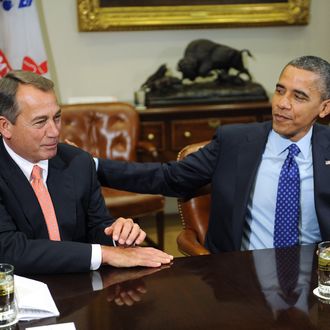
The front page of today’s Wall Street Journal offers a peek behind the closed doors of President Obama and John Boehner’s one-on-one budget negotiations, and it’s not very pretty. Reportedly, in a White House meeting a couple weeks ago, “The president told [Speaker Boehner] he could choose one of two doors. The first represented a big deal. If Mr. Boehner chose it, the president said, the country and financial markets would cheer. Door No. 2 represented a spike in interest rates and a global recession.” Boehner asked Obama if he’d accept a “big deal” along the lines of the so-called “grand bargain” that he walked away from last year. The president’s retort: “You missed your opportunity on that.”
In an Oval Office meeting last week, Obama also threatened to use his inaugural speech and upcoming State of the Union Address to lay all the blame for going over the fiscal cliff at the Republicans’ feet. In response, Boehner wondered, “I put $800 billion [in tax revenue] on the table. What do I get for that?” Obama — no doubt petting an enormous, sinister-looking white cat — supposedly replied, “You get nothing. I get that for free.” Since the story came out, Politico’s Mike Allen has claimed that the president “was referring to public concessions by Rep. Tom Cole and Senate [Republicans] on the need to raise rates. So the White House didn’t have to trade anything for that.” Still, that line sounds like a pretty big burn to us, whatever the context.





























